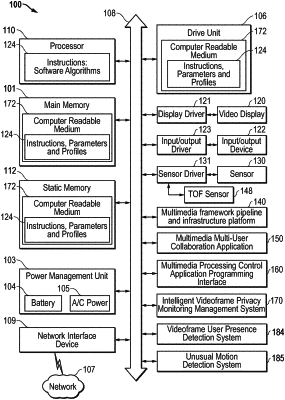| CPC H04N 7/147 (2013.01) [G06N 3/08 (2013.01); G06T 5/002 (2013.01); H04N 5/2621 (2013.01); H04N 5/272 (2013.01); H04N 7/152 (2013.01)] | 20 Claims |

|
1. An information handling system executing an intelligent videoframe privacy monitoring management system comprising:
a processor configured to execute code instructions of a multimedia multi-user collaboration application to join a videoconference session with a remotely located computing device;
a display screen, a speaker, a video camera, and a microphone;
the video camera system configured to capture videoframes of a user and background in the videoconference session;
the processor to execute code instructions of a user presence detection module with sensor data, including the video camera system, time of flight (TOF) sensor, or a microphone, to detect distance data for the user or objects in front of the video camera system;
the processor to input videoframes and the detected distance data from the user presence detection module of the user or the objects, to a trained neural network of the intelligent videoframe privacy monitoring management system to use the detected proximity sensor distance data to identify the presence or absence of the user and the videoframe data to identify the user;
the processor to execute code instructions the intelligent videoframe privacy monitoring management system to output determination of the user's presence or absence, to identify an image of the user as a videoconference participant, and then to generate an optimized videoframe privacy adjustment correlated to the user's absence, where the optimized videoframe privacy adjustment includes generating AV processing instruction adjustment to apply a privacy alteration to captured videoframes when the user is detected as absent even when another person not identified as the user is present; and
a network interface device configured to transmit a processed, encoded media sample, including the captured videoframes with any applied privacy alteration to a remotely located computing device participating in the videoconference session.
|